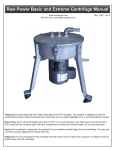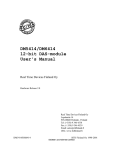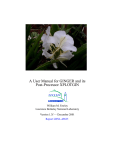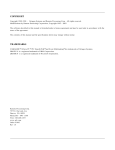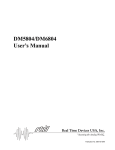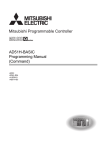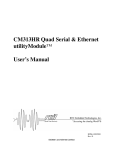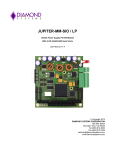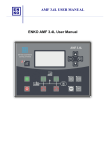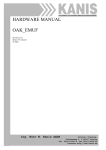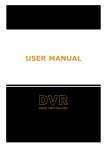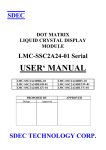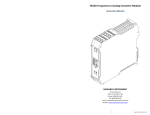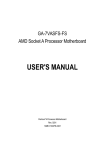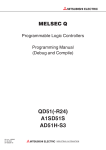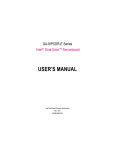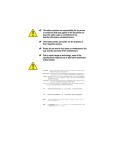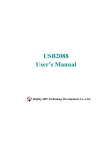Download MSI-NC911 User Manual - Microcomputer Systems, Inc.
Transcript
MSI-NC911 3 Ch. Counter/timer & 24 Bit DIO Module 1 Copyright IBM is a trademark of International Business Machines Corporation. MS-DOS, MICROSOFT C and Quick BASIC are trademarks of Microsoft Corporation. TURBO C is a trademark of Borland Inc. BASIC is a trademark of Dartmouth College. Intel is a trademark of Intel Corporation 2 CHECK LIST Before getting started, check if your NC – 911 24 Bit DIO & 3Ch. Counter/Timer Module package includes the following items: zNC – 911 board z Screw 3mm (x 4) z Bronze stick 6mm (x 4) z NC – 911 User’s Manual z Warranty card If anything is missing, please contact your dealer. 3 Table of Contents CHAPTER 1 INTRODUCTION ................................................................ 1 General Description............................................................... Applications............................................................................ Features................................................................................... Specifications.......................................................................... Accessories Guide .................................................................. 1 1 2 3 5 CHAPTER 2 MODULE CONFIGURATION AND INSTALLATION .. 6 Component Locator Diagram............................................... 6 Base Address Switch .............................................................. 7 Interrupt Select Jumper........................................................ 9 +12V or Ground Selection ....................................................10 Connector Pin Assignment .....................................................11 Resistor Pack ..........................................................................13 Hardware Description ...........................................................14 Hardware Installation ...........................................................14 CHAPTER 3 REGISTER STRUCTURE AND FORMAT ...................... 16 NC-911/910 I/O Address Map ..............................................16 8254 Counter Data and Control Registers ..........................17 Digital I/O Registers ..............................................................20 CHAPTER 4 PROGRAMMING ................................................................ 22 Programming Examples .......................................................22 APPENDIX A PC I/O PORT MAPPING .................................................. 23 APPENDIX B BLOCK DIAGRAM ........................................................... 24 APPENDIX C TECHNICAL REFERENCE ............................................ 25 General Usage of Digital Input and Output .......................25 NC-911/910 Port A, B and C Basic Definition ....................27 APPENDIX D PROGRAMMING 8254 COUNTER/TIMER ................. 28 Introduction ...........................................................................28 Counter Read/Write and Control Register .........................28 Read-Back Command ...........................................................30 Counter Operating Mode .....................................................32 Programming Counter/Timer ..............................................35 APPENDIX E PC/104 MECHANICAL SPECIFICATION .................... 37 PC/104 General Description .................................................37 Module Dimensions ...............................................................37 4 CHAPTER 1 INTRODUCTION General Description The NC- 911/910 is a PC/104 module which is primary intended to PC embedded application in industrial environment. It contains 24 digital input/output channels and 3 counter/timer channels. The 24-bit digital input and output are arranged to emulate 8255 PPI (Programmable Peripheral Interface) chip mode 0 but with stronger driving capability. The 24-bit DIO is further divided into three 8-bit ports (Port A, Port B and Port C) which can be functionally programmed as either digital input or digital output ports. There is a unique feather associated with NC-911/910. An external input interrupt ability. This feature frees up the PC to do other activities since there is on need to poll the digital input for an event to occur. For timing functions, the NC-911/910 uses the popular 8254 integrate chip. The 8254 has three programmable counters and can be used as event counter, rate generator, square wave generator, frequency measurement, etc. Applications zSense and control high level signals through I/O module. zSense low level (TTL) switches or signals. zDrive indicator light or control recorders. zParallel data transfer to PC. zPeriod and pulse width measurement. zEvent and frequency counting. zWaveform and pulse generation. zBaud rate generator. 5 Features z PC/104 standard expansion module. z 24 TTL/DTL digital I/O lines. z 24mA output drive/sink current. z Easy interface to high level signals. z Three 8-bit ports independently selectable for I/O. z 3 programmable counter/timer channels. z Include timed interrupt generation. z 50-pin digital connector compatible with NC-951, NC-954, NC-955 or NC956 accessory board. 6 Specifications Digital I/O Number of Channels 24 I/O Configuration TTL/DTL compatible Operation Mode Emulates 8255 mode 0 Input / Output Mode Pair Improved Noise Margins Hysteresis VT+ -VT - =0.4(typ.) Added Pull-up Resistor CMOS/dry contact compatible Digital Input Logic High Input Voltage Logic Low Input Voltage Logic High Input Current Logic Low Input Current 2V min 0.8V max 20uA max. at VI=2.7V –0.2mA max. at VIL=0.4V Digital Output Logic High Output Voltage Logic Low Output Voltage Logic High Output Current Logic Low Output Current 2.4V min. at IOH=-3mA 0.4V max. at IOL=12mA –15mA source max. 24mA sink max Programmable Counter/Timer Type 82C54 Number of Counters 3 independent 16-bit counters Frequency Range DC to 10MHz Modes 6 programmable mode Input / Output Level TTL, DTL, CMOS compatible 7 Interrupt PC bus IRQ 9(2), 5, 10, 11, 12, 15 Source Enable control and positive trigger Power Requirement +5V 200mA typ Physical/Environmental I/O Connector 50-pin male ribbon connector 20-pin male ribbon connector I/O Cable Type Ribbon stripline cable (ZO=30Ωto 80Ω ) Dimensions 95mm * 90mm Weight 200g Operating Temperature 0 to 60℃ Storage Temperature –40 to 100℃ Humidity 0 to 90%, non-condensing 8 Accessories Guide NC-951 Screw terminal board for all digital I/O connections. Shipped with 3.3 feet (1 meter) cable and 50-pin connector. NC-954 24-channel opto-isolated D/I panel for signal connection and conditioning with the NC-911/910. Shipped with 3.3 feet (1 meter) cable and 50-pin connector. NC-955 8-channel electromechanical single-pole, double-throw (SPDT) and 16-channel opto-isolated digital I/P panel which is compatible with the NC-911/910 Shipped with 3.3 feet (1meter) cable and 50-pin connector. NC-956 24-channel electromechanical single-pole, double-throw (SPDT) which can be driven by the NC-911/910. Shipped with 3.3 feet (1 meter) cable and 50-pin connector. 9 CHAPTER 2 MODULE CONFIGURATION AND INSTALLATION Component Locator Diagram The following figure shows the location of NC-911/910’s component. All switch and jumper settings in this figure are factory default setting. CN1 1 2 CN2 M5M8SC54P U8 JP1 ON GAL16V8 SW1 1 2 3 4 5 6 7 8 JP2 10 Base Address Switch NC-911/910 occupies eight consecutive I/O port spaces. The I/O port addresses are set via a DIP switch labeled SW1. Set the DIP switch to correct address and avoid conflicting with other devices (refer to APPENDIX A for I/O port distribution). Valid addresses are from 200Hex to 3F8 Hex. Following figure is the default setting where the base address is set to 220 Hex. To set to appropriate base address, switch the individual switches into the ON or OFF position. Figure below shows the DIP switch default setting, 220 Hex, where switches 1 and 5 are moved to the OFF position while leaving all other switches in the ON position. A table for DIP switch setting is given in the following page. . BASE ADDRESS SWITCH SETTING ON 1 2 3 4 5 6 7 8 8 16 32 64 128 256 512 Weighting X: Not used. Base Address = 512 + 32 = 544 (Decimal) =220 (Hexadecimal) 11 I/O PORT RANGE HEXADECIMAL DIP SWITCH POSITION 200 – 207 1 A1 0 2 A2 0 3 A3 0 4 A4 0 5 A5 0 6 A6 0 7 A7 1 8 X X 208 – 20F 1 0 0 0 0 0 1 X 210 – 217 0 1 0 0 0 0 1 X 218 – 21F 1 1 0 0 0 0 1 X 220 – 227 (*) . . 300 – 307 . . 3F0 – 3F7 0 0 1 0 0 1 X 0 0 0 0 1 1 X 0 1 1 0 . . 0 . . 1 1 1 1 X 3F8 – 3FF 1 1 1 1 1 1 1 X 0 = ON, 1 = OFF, (*): Factory Default Setting X = don’t care 12 Interrupt Select Jumper The NC-911/910 accept external inputs at INTE and INTP pins of CN2 20-pin connector. These inputs are lead to any of the six interrupt request lines (IRO level 9(2), 5, 10, 11, 12, 15) by the following jumpers JP1 1 2 IRQ9(2) 3 4 IRQ5 IRQ10 IRQ11 IRQ12 IRQ15 13 14 No connect In factory jumper JP1 pin13-pin14 is installed on . 13 12V or Ground Selection Pin 2 and pin 4 of CN1 (50-pin connector) can be set to output PC + 12V or Ground by setting jumper JP2. The JP2 configuration is listed in below table. JP2 JP2 JP2 jumper configuration 1 Factory default setting Pin 2 and 4 at CN1 connector CN1 compatible Connected to Ground JP2 1 Connected to +12V NC9416, NC9424 NC-954, NC955, ect. NC956, ect. Jumpering PC +12V to CN1 connector allows the NC-911/910 to provide +12v power for direct relay driving voltage or input pull high voltage. Note that when using the NC-911/910 with standard Opto-22 interface panel board, pins 1 and 2 of JP2 jumper must be connected. 14 Connector Pin Assignment All NC-911/910 DIO signals are built into a 50-pin connector labeled CN1 whose pin assignment are shown below. Via this connector the NC-911/910 is compatible with NC-951, NC954, NC754, NC756 accessory board or standard Opto-22 interface panel. NAME PIN Ground Ground Ground Ground Ground Ground Ground Ground Ground Ground Ground Ground Ground Ground Ground Ground Ground Ground Ground Ground Ground Ground Ground (*) (*) 50 48 46 44 42 40 38 36 34 32 30 28 26 24 22 20 18 16 14 12 10 8 6 4 2 PIN 49 47 45 43 41 39 37 35 33 31 29 27 25 23 21 19 17 15 13 11 9 7 5 3 1 NAME I/O CHANNEL + 5V PA 0 PA 1 PA 2 PA 3 PA 4 PA 5 PA 6 PA 7 PB 0 PB 1 PB 2 PB 3 PB 4 PB 5 PB 6 PB 7 PC 0 PC 1 PC 2 PC 3 PC 4 PC 5 PC 6 PC 7 0 1 2 3 4 5 6 7 8 9 10 11 12 13 14 15 16 17 18 19 20 21 22 23 +5V : + 5V PC power supply ( * ) : These pins can be connected to + 12V PC power or Ground by jumpering JP2. Refer to +12V or Ground Selection section. 15 WARNING As pin 2 and pin 4 of CN1 can be connected to GND or +12V, by setting JP2 jumper, thus when the NC-911/910 is connected to other card through this 50-pin connector, user must pay attention to the connector pin assignment (especially pins 2 and 4) of the corresponding card. All input or output lines of NC-911/910 counter/timer are built into CN2 (20-pin connector). The CN2 connector pin assignments are as follows: NAME PIN CLK0 G0 OUT0 CLK1 G1 OUT1 CLK2 G2 OUT2 N/C 1 3 5 7 9 11 13 15 17 19 CLK0 – CLK2 +12V G0 – G2 GND OUT0 – OUT2 10MHz INTP INTE N/C +5V : : : : : : : : : : PIN NAME 2 4 6 8 10 12 14 16 18 20 + 12V GND GND GND 10MHz GND INTP INTE GND + 5V Clock input to 8254 counter 0 through 2 +12V PC power Gate control input to 8254 counter 0 through 2 Ground Output from 8254 counter 0 through 2 10MHz frequency output Interrupt trigger input Interrupt enable input No connect +5V PC power 16 Resistor Pack As mentioned before the 8-bit port digital I/O lines can be configured as input or output port (refer to Chapter 3). Initially the digital I/O lines are left floating. When any of these ports is set to input port, user is suggested to pull high it’s input lines by installing RP(s). Onboard there are 3 reserved spaces, marked as RP1-RP3 (refer to table below, the RP is approximately 4.7k). If a port is configured as output lines, just leave the corresponding RP unoccupied. If CN1 is connected to NC9416 and NC9424, the RP should be installed to prevent power-on floating phenomenon. This floating may cause SSR to action (switch on). DIO Lines Port A RP RP3 Port B RP2 Port C RP1 NOTE: In some situations, i.e. environment ground is not stable, the digital output reset frequently. User is suggested to isolate system circuitry from external signal. Let the external signal to go through NC-954 (24 channel opto-isolated D/O panel) or NC955 (8 channel relay output and 16 channel opto-isolated D/I panel) or NC956 (24 channel relay output) before reaching the system circuitry. 17 Hardware Description PC/104 module can be of two bus types, 8 bit and 16 bit. These correspond to the PC and PC/AT buses, respectively. The detailed mechanical dimensions of these two PC/104 bus types are provided in APPENDIX E PC/104 MECHANICAL SPECIFICATIONS. Basically the NC-911/910 belongs to 16 bit bus option which is designed only to by pass PC/AT bus signal in order to compatible to PC/AT type PC/104 module. The NC-911/910 use only IRQ lines on P2 40-pin connector. If this module is going to plug onto PC type PC/104 bus, do not use IRQ line above 10. Beside bus option, there are stack through and non-stack through difference. The stack through version provides a self-stacking PC bus. It can be placed any where in a multi-module stack. The non-stack through version offers minimum thickness, by omitting bus stack through pins. It must be positioned at one end of a stack. For convenience, the NC-911/910 is equipped with stack through version only. (NOTE: For safety, you are suggested to cut bus stack through pins of the last module on condition; that you are sure you won’t add/plug any module to the module stack in the future.) Hardware Installation The NC-911/910 PC/104 module is shipped witch protective electrostatic cover. When unpacking, touching the module electrostatically shielded packaging with the metal frame of your computer to discharge the accumulated static electricity prior to touching the module. Following description summarizes the procedures for installing the NC-911/910. WARNING TURN OFF the PC and all accessories connected to the PC whenever installing or removing any peripheral board including the NC-911/910 module. 18 Installation procedures: 1. Turn off the system power. 2. Unplug all power cords. 3. Remove the case cover if necessary. 4. Remove the top module if it a non-stackthrough module. 5. Put the NC-911/910 module in line with the top present module as described in APPENDIX E PC/104 MECHANICAL SPECIFICATION. 6. Install four spacers if necessary. 7. Connect cable to CN2 if necessary. 8. Crush between the module until inside distance is SPACER’s height (0.6”). Restore all the screws. 9. Repeat step 6 until all module are set into position. 10. Connect cable (CN1) to CN-911/910 if necessary. 11. Replace the case cover and connect all the necessary cables. 12. Turn on the system power. 19 CHAPTER 3 REGISTER STRUCTURE AND FORMAT NC-911/910 I/O Address Map This chapter describes each NC-911/910 register in terms of function, address, bit structure and bit function. Each register is easy to read and write to by using direct I/O instructions of whatever application languages. NC-911/910 uses 8 consecutive addresses in I/O space as follows (R= Read, W= Write): Location Base address + Function Type 0 Counter 0 R/W +1 Counter 1 R/W +2 Counter 2 R/W +3 Control Word W +4 Port A R/W +5 Port B R/W +6 Port C R/W +7 Control Register W 20 8254 Counter Date and Control Registers Counter 0 Data Register (Base +0, R/W) base +0 7 B7 6 B6 5 B5 4 B4 3 B3 2 B2 1 B1 0 B0 2 B2 1 B1 0 B0 3 B3 2 B2 1 B1 0 B0 3 M2 2 M1 1 M0 0 BCD Counter 1 Data Register (Base +1, R/W) base +1 7 B7 6 B6 5 B5 4 B4 3 B3 Counter 2 Data Register (Base +2, R/W) base +2 7 B7 6 B6 5 B5 4 B4 Counter Word Register (Base +3, W) base +3 7 SC1 6 SC0 5 RW1 4 RW0 21 Where SC – Counter `SC1 0 0 1 1 SC0 0 1 0 1 Description Select Counter 0 Select Counter 1 Select Counter 2 Read-back Where RW – Read/Write RW1 0 0 1 1 RW0 0 1 0 1 Description Counter latch command R/W LSB only R/W MSB only R/W LSB first, then MSB Where M – Mode M2 0 0 X X 1 1 M1 0 0 1 1 0 0 M0 0 1 0 1 0 1 Description Mode 0 : Pulse on terminal count Mode 1 : Programmable one-shot Mode 2 : Rate generator Mode 3 : Square wave mode Mode 4 ; Software triggered mode Mode 5 : Hardware triggered strobe BCD – Binary Coded Decimal: BCD O 1 Description Binary counter 16 - bit Binary coded decimal (BCD)counter (4 decodes) NOTE: This module uses 8254 integrate chip for its programmable counter/timer channels. Refer to APPENDIX D PROGRAMMING 8254 COUNTER/TIMER or the 8254 Data Book for detailed information. 22 Digital I/O Registers The 24 digital I/O lines of NC-911/910 are arranged into one group. This group emulates 8255 PPI chip mode 0 and is further divided into three ports; Port A, Port B and Port C . The NC-911/910 is programmable through the configuration registers. By writing to control registers, the I/O direction of each port may be specified. If a port is configured as a write (output) port, the data drives will drive the data value to the corresponding port. If a port is configured as a read (input) port, the data value on corresponding port will be sent to the digital I/O lines. Only port C is different from the other two ports, that is Port C consists of two 4-bit ports, Port C-upper and C-lower, which can separately be configured as input or output port. Port A Data Register (Base +4, R/W) base +4 7 PA7 6 PA6 5 PA5 4 PA4 3 PA3 2 PA2 1 PA1 0 PA0 3 PB3 2 PB2 1 PB1 0 PB0 3 PC3 2 PC2 1 PC1 0 PC0 Port B Data Register (Base +5, R/W) base +5 7 PB7 6 PB6 5 PB5 4 PB4 Port C Data Register (Base +6, R/W) base +6 7 PC7 PC0 – PC3 : PC4 – PC7 ; 6 PC6 5 PC5 4 PC4 Port C – lower Byte P0rt C – upper Byte 23 Control Register (Base + 7, W) base +7 7 X 6 X 5 X 4 D4 3 43 2 X 1 D1 0 D0 Port A Port C – upper Port B Port C – lower NOTE: PA0 – PA7, PB0 – PB7and PC0 – PC7 bits are associated to pins at CN1 connector. X = don’t care For D0, D1, D3, D4 : 1 → Input, 0 → Output 24 CHAPTER 4 PROGAMMING NC-911/910 provides 24 bit digital I/O which are divided into three 8-bit ports (A, B and C). Port C is divided into two 4-bit nibbles; Port C- upper and C- lower. The I/O direction of the ports (Port A, B, C-upper and C-lower) can be determined by programming to the control register. Programming Examples The following BASIC program configures Port A and B as input port (install corresponding RP’s if necessary ), Port C as output port. An increasing pattern is sent to Port C. It is expected that user will connect both Port A and Port B to Port C before running this program. 10 CLS 20 PORT% = &H220 30 OUT PORT% + 7, &H92 40 FOR C = 0 to 255 50 OUT PORT% + 6, C 60 A = INP (PORT% + 4) 70 B = INP (PORT% + 5) 80 PRINT A, B, C 90 NEXT C 100 END ’REM Base Address ’REM Port A, B: input, Port C: output ’REM decimal value form 00 to FF ’REM output data to Port C ’REM read data on Port A ’REM read data on Port B ’REM check data versus Port A and B 25 APPENDIX A PC I/O PORT MAPPING I/O Port Address Range Function 000 – 1FF PC reserved 200 – 20F Game controller (Joystick) 278 – 27F Second parallel print port (LPT2) 2E1 GPIB controller 2F8 – 2FF Second serial port (COM2) 320 – 32F Fixed disk (XT) 378 – 37F Primary parallel print port (LPT1) 380 – 38F SDLC communication port 3B0 – 3BF Monochrome adapter/printer 3C0 – 3CF EGA, reserved 3D0 – 3DF Color/graphics adapter 3F0 – 3F7 Floppy disk controller 3F8 – 3FF Primary serial port (COM1) 26 B U S P C / 1 0 4 Interrupt Control Logic Address Decode Logic PC3 – PC0 Group #1 A Port INTE INTP PC7 – PC4 PB7 – PB0 PA7 – PA0 CLK0 – CLK2 GATE0 – GATE2 OUT0 – OUT2 Group #1 A Port Group #1 A Port Group #1 A Port 8254 APPENDIX B BLOCK DIAGRAM 27 APPENDIX C TECHNICAL REFERENCE General Usage of Digital Input and Output Digital signals are usually used for detecting logical status or controlling devices, a brief description is given below. TTL level signals are developed by most DAS systems. TTL or LSTTL Level I/O Connections TTL Devices DO DI DGND Connection with COMS Device – Use a pull-up resistor if you wish to interface to COMS devices. This will raise the logic high output level from its minimum TTL level of 2.4 to +5V suitable for COMS interface. VCC PULL-UP RESISTOR TTL CMOS 28 Digital Input for Open / Short Switch Detection – A pull-up resistor must be connected, especially at long distance wiring, to ensure logic high input level. +5V 4.7K DI Switch Digital Input for Large Signal DI R Digital Output for Relay Driving – The D1 diode is added to protect the IC driver against the inductive “kickback” from the relay coil. VCC D1 DO 29 NC-911/910 Port A, B and C Basic Definition (1) Equivalent ckt of port A, B and C VCC Pull High Resistor Internal Data Bus Data Write Pulse D Q Line Driver 74LS244 74LS273 Control Port Data Control Port Write Pulse 50 Pin Connector PA0 – PA7 PB0 – PB7 PC0 – PC7 D Q Line Receiver 74LS273 74LS244 Read pulse NOTE: Optional Resistor Pack ( Not Installed Factory ) (2) (3) (4) (5) (6) Any port is programmable to input or output. Outputs are drived by 74LS244 and latched by 74LS273. Input s are received by 74LS244 but not latched. All inputs and outputs are buffered by standard line drives and line receivers. The initial state and default setting of port A, B and C are tri-state. 30 APPENDIX D PROGRAMMING 8254 COUNTER/TIMER Introduction AXIOM’s NC-911/910 module uses INTEL 8254 which consist of three independently programmable 16-bit counters for its timing function. Each counter can be programmed to be divided by number within the range of 2 – 65535. The 8254 is suitable for: z z z z Event counter Delay time generator Programmable one-shot Square wave generator For detailed information, user should refer to the 8254 Timer data sheet. Programmable Interval Counter Read/Write and Control Register There are 4 registers needed to program 8254 Time/Counter, including three Read/Write and one Control register as follows: Base +0 through Base +3: Base +0 Base +1 Base +2 Base +3 Counter 0 Read/Write register Counter 1 Read/Write register Counter 2 Read/Write register Control word register Read/Write register is used to load divisor to select counter, or Read count from selected counter. Control register is used to determine counter’s operation. 31 Control Word Format Addr . base +3 D7 D6 D5 D4 D3 SC1 SC0 RW1 RW0 M2 D2 M1 SC – Select Counter : SC1 SC0 0 0 Select Counter 0 0 1 Select Counter 1 1 0 Select Counter 2 1 1 Read- Back Command (see read operations) RW – Read/Write : RW1 RW0 0 0 Counter Latch Command (see read operation) 0 1 Read/Write least significant byte only. 0 Read/Write most significant byte 1 1 Read/Write least significant byte first, then most significant byte D1 D0 M0 BDC M – Mode : M2 M1 M0 0 0 0 0 0 1 X 1 0 X 1 1 1 0 0 1 0 1 Mode0 Mode1 Mode2 Mode3 Mode4 Mode5 BCD – Binary Coded Decimal 0 Binary Counter 16-bits 1 Binary Coded ecimal (BCD) (4 Decades) NOTE: Don’t care bits (X) should be 0 to insure compatibility with future products. 32 Read- Back Command The read-back command allows the user to check the count value, programmed Mode, and current state of the OUT pin and Null Count flag of the selected counter(s). The command is written into the Control Word Register and has the format shown in the preceeding page. The command applies to the counter selected by setting their corresponding bits D3, D2, D1 = 1. Base Addr . +3 D7 D6 D5 D4 D3 D2 D1 1 1 COUNT STATUS CNT 2 CNT 1 CNT 0 D0 0 D5: 0 = Latch count of selected Counters(s) D4: 0 = Latch status of selected Counters(s) D3: 1 = Select Counter 2 D2: 1 = Select Counter 1 D1: 1 = Select Counter 0 D0: Reserved for future expansion, Must be 0 Here is an example for read-back command: DESCRIPTION COMMAND RESULT D7 D6 D5 D4 D3 D2 D1 D0 1 1 0 0 0 0 1 0 Read back count and status of Counter 0 0 0 Read back status of Counter 1 0 0 Read back status of Counter 2 and 1 1 1 1 0 0 1 1 1 1 0 1 1 1 1 0 1 1 0 0 1 1 0 0 0 1 0 1 1 1 0 0 0 1 0 Read back count of Counter 2 0 Read back count and status of Counter 1 0 Read back status of Counter 1 Count and status latched for Counter 0 Count latched for Counter 1 Status latched for Counter 2, but not Counter 1 Count latched for Counter 2 Count latched for Counter 1, but not status Command ignored status already latched for Counter 1 33 Counter Operating Mode Mode 0 : Interrupt on Terminal Count Mode 0 is typically used for event counting. After the Control Word is written , OUT is initially low, and will remain low until the Counter reaches Zero. OUT then goes high and remains high until a new count or a new Mode 0 Control Word is written to the Counter . GATE = 1 enables counting; GATE = 0 disables counting. GATE has no effect on OUT. After the Control Word and initial count are written to a Counter, the initial count will be loaded on the next CLK pulse. This CLK pulse does not decrement the count, so for an initial count of N, OUT does not go high until N + 1 CLK pulses after the initial count is written If a new count is written to the Counter it will be loaded on the next CLK pulse and counting will continue form the new count If a two-byte count is written, the following happens: zWriting the first byte disables counting. Out is set low immediately (no clock pulse required) zWriting the second byte allows the new count to be loaded on next CLK pulse. Mode 1: Hardware Retriggerable One-Shot OUT will be initial high. OUT will go low on the CLK pulse following a trigger to begin the one-shot pulse, and will remain low until the Counter reaches zero. OUT will then go high and remain high until the CLK pulse after the next trigger. After writing the Control Word and initial count, the Counter is armed. A trigger results in loading the Counter and setting OUT low on the next CLK pules, thus starting the one-shot pulse N CLK cycles in duration. The one-short pulse can be repeated without rewriting the same count into the counter. GATE has no effect on OUT. If a new count is written to the Counter during a one-short pulse, the current one-shot is not affected unless the Counter is retriggered. In that case, the Counter is loaded with the new count and the one-shot pulse continues until the new count expires. 34 Mode 2: Rate Generator This Mode functions like a divide-by-N counter. It is typically used to generate Real Time Clock interrupt. OUT will initial be high. When the initial count has decremented to 1, OUT goes low for one CLK pulse. OUT the goes high again, the Counter reloads the initial count and the process is repeated Mode 2 is periodic; the same sequence is repeated indefinitely. For an initial count of N, the sequence repeats every N CLK cycles. After writing a Control Word and initial count, the Counter will be loaded on the next CLK pulse. OUT goes low N CLK pulses after the initial count is written. This allows the Counter to be synchronized by software also Mode 3: Square Wave Mode Mode 3 is typically used for Baud rate generation. Mod 3 is similar to Mode 2 except for the duty cycle of OUT. OUT will initial be high. When half the initial count has expired, OUT goes low for the remainder of the count. Mode 3 is periodic; the sequence above is repeated indefinitely. An initial count of N results in a square wave with a period of N CLK cycles. After writing a Control Word and initial count, the Counter will be loaded on the next CLK pulse. This allows the Counter to be synchronized by software also. Mode 3 is implemented as follows: EVEN COUNTS: OUT is initial high. The initial count is loaded on one CLK pulse and then is decrement by two on succeeding CLK pulses. When the count expires, OUT changes value and the Counter is reloaded with the initial count. The above process is repeated indefinitely. ODD COUNTS: OUT is initial high. The initial count is loaded on one CLK pulse, decremented by one on the next CLK pulse, and then decremented by two on succeeding CLK pulses. When the count expires, OUT goes low and the Counter is reloaded with the initial count. The count is decremented by three on the next CLK pulse, and then by two on succeeding CLK pulses. When the count expires, OUT goes high again and the Counter is reloaded with the initial count. The above process is repeated indefinitely. So for odd counts, OUT will be high for (N + 1)/2 counts and low for (N – 1)/2 counts. 35 Mode 4:Software Triggered Mode OUT will be initial high. When the initial count expires, OUT will go low for one CLK pulse the go high again. The counting sequence is “Triggered” by writing the initial count. After writing a Control Word and initial count, the Counter will be loaded on the next CLK pulse. This CLK pulse does not decrement the count, so for an initial count of N, OUT does not strobe low until N + 1 CLK pulses after the initial count is written. If a new count is written during counting, it will be loaded on the next CLK pulse and counting will counting form the new count. If a two-byte count is written, the following happens: zWriting the first byte has no effect on counting. zWriting the second byte allows the new count to be loaded on the next CLK pulse. This allows the sequence to be “retriggered” by software OUT strobes low N + 1 CLK pulses after the new count of N is written. Mode 5: Hardware Triggered Strobe (Retriggerable) OUT will initial be high. Counting is triggered by a rising edge of GATE. When the initial count has expired, OUT will go low for one CLK pulse and then go high again. 36 Programming Counter/Timer Programming Sequence: 1.Writing control word to select counter and determine operation. 2.Program selected counter’s LSB of R/W register. 3.Program selected counter’s MSB of R/W register. Addr . Base + Addr. Base + Control Word LSB of count MSB of count Control Word LSB of count MSB of count Control Word LSB of count MSB of count - Counter 0 - Counter 0 - Counter 0 - Counter 1 - Counter 1 - Counter 1 - Counter 2 - Counter 2 - Counter 2 3 0 0 3 1 1 3 2 2 Control Word Control Word Control Word LSB of count MSB of count LSB of count MSB of count LSB of count MSB of count - Counter 2 - Counter 1 - Counter 0 - Counter 2 - Counter 2 - Counter 1 - Counter 1 - Counter 0 - Counter 0 3 3 3 2 2 1 1 0 0 Control Word Control Word Control Word LSB of count LSB of count LSB of count LSB of count MSB of count MSB of count - Counter 0 - Counter 1 - Counter 2 - Counter 2 - Counter 1 - Counter 0 - Counter 0 - Counter 1 - Counter 2 3 3 3 2 1 0 0 1 2 Control Word Control Word LSB of count Control Word LSB of count MSB of count LSB of count MSB of count MSB of count - Counter 1 - Counter 0 - Counter 1 - Counter 2 - Counter 0 - Counter 1 - Counter 2 - Counter 0 - Counter 2 3 3 1 3 0 1 2 0 2 NOTE: In all four examples, all counters are programmed to Read/Write two-byte count is. These are only four of many possible programming sequences. 37 Simple programming examples written in BASIC are given as follow: Example 1 Program counter 0 as rate generator 10 20 30 40 50 60 70 Divisor % = 100 LSB % = Divisor % MOD 256 MSB % = Divisor % \ 256 Base % = & H220 OUT Base % + 3, & H34 OUT Base % + 0, LSB % OUT Base % + 0, MSB % ’Counter 0: rate generator ’Write low byte to counter o ’Write high byte to counter o Example 2 Read count of counter o 10 Bas % = & H220 20 OUT Base % + 3, 0 30 LSB % = inp (Base % + 0) 40 MSB% = inp(Base % + 0) 50 Count % = LSB% + MSB% * 256 ’Latch counter o ’Read low byte from counter o ’Read high byte from counter o ’Read count from counter 0 38 APPENDIX E PC/104 MECHANICAL SPECIFICATION PC/104 General Description While the PC and PC/AT architectures have become extremely popular in both general purpose (desktop) and dedicated (non-desktop) applications, its use in embedded microcomputer applications has been limited due to the large size of standard PC and PC/AT motherboard and expansion cards. This document supplies the mechanical and electrical specifications for a compact version of the PC/AT bus, optimized for the unique requirements of embedded systems applications. The specification is herein referred to as “PC/104”, based on the 104 signal contacts on the two bus connectors (64 pin on P1 plus 40 pins onP2) . Module Dimensions PC/104 modules can be of two bus types, 8-bit and 16-bit. These correspond to the PC and PC/AT buses, respectively. 39







































